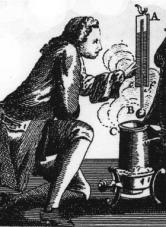 In 1593, when Galileo Galilei invented a basic water thermometer the device was called a thermoscope. His thermoscope and the ones that followed were not standardized in the liquid or the scale for telling the temperature. These simple devices mainly indicated a temperature increase or decrease, but no one was sure by how much. Daniel Gabriel Fahrenheit was a German physicist who changed the way the world viewed temperature.
In 1593, when Galileo Galilei invented a basic water thermometer the device was called a thermoscope. His thermoscope and the ones that followed were not standardized in the liquid or the scale for telling the temperature. These simple devices mainly indicated a temperature increase or decrease, but no one was sure by how much. Daniel Gabriel Fahrenheit was a German physicist who changed the way the world viewed temperature.
In 1709, Fahrenheit invented an alcohol thermometer. Then in 1714, he improved on this invention with the introduction of the mercury thermometer. Fahrenheit decided to use mercury after a series of experiments. Mercury expanded uniformly at temperatures ranging from negative 40 to 626 degrees. Fahrenheit also changed the design of thermometers. Previously, thermometers were spherical. A tiny glass bulb held the mercury which rose through a long, cylindrical neck.
 Fahrenheit’s work with the thermometer eventually led to him devising a temperature scale. He published this new scale in 1724. He based his scale on three reference points. 0 degrees represented the coldest temperature Fahrenheit could produce in his laboratory by combining ice and salt. Thirty degrees represented the freezing point of water and 100 degrees represented the average human body temperature. Marks indicating the level of mercury at these temperatures were made on Fahrenheit thermometer and then additional degree marks were made between them completing a temperature scale similar to what is in use now. Later the scale was redefined slightly to make the freezing point of water 32 degree and the boiling point 212 degrees.
Fahrenheit’s work with the thermometer eventually led to him devising a temperature scale. He published this new scale in 1724. He based his scale on three reference points. 0 degrees represented the coldest temperature Fahrenheit could produce in his laboratory by combining ice and salt. Thirty degrees represented the freezing point of water and 100 degrees represented the average human body temperature. Marks indicating the level of mercury at these temperatures were made on Fahrenheit thermometer and then additional degree marks were made between them completing a temperature scale similar to what is in use now. Later the scale was redefined slightly to make the freezing point of water 32 degree and the boiling point 212 degrees.
The Fahrenheit scale was the temperature scale used for weather, medical and industrial purposes in English speaking countries until the 1960’s. The scale was then replaced in most countries by Celsius. Today only the United States and Belize still use Fahrenheit for most applications. Canada uses Celsius for weather reporting but stoves and other things are still measured in Fahrenheit.
